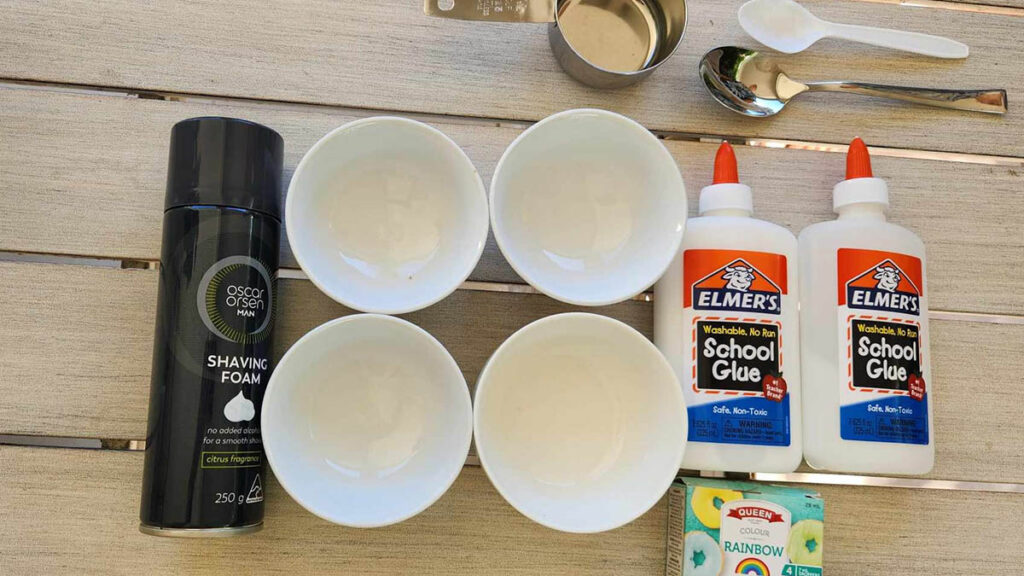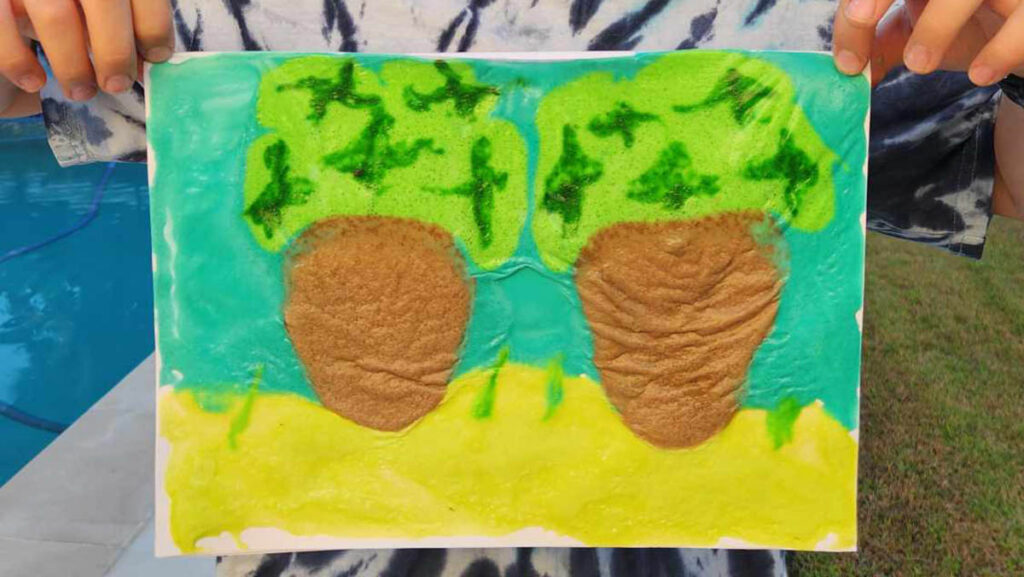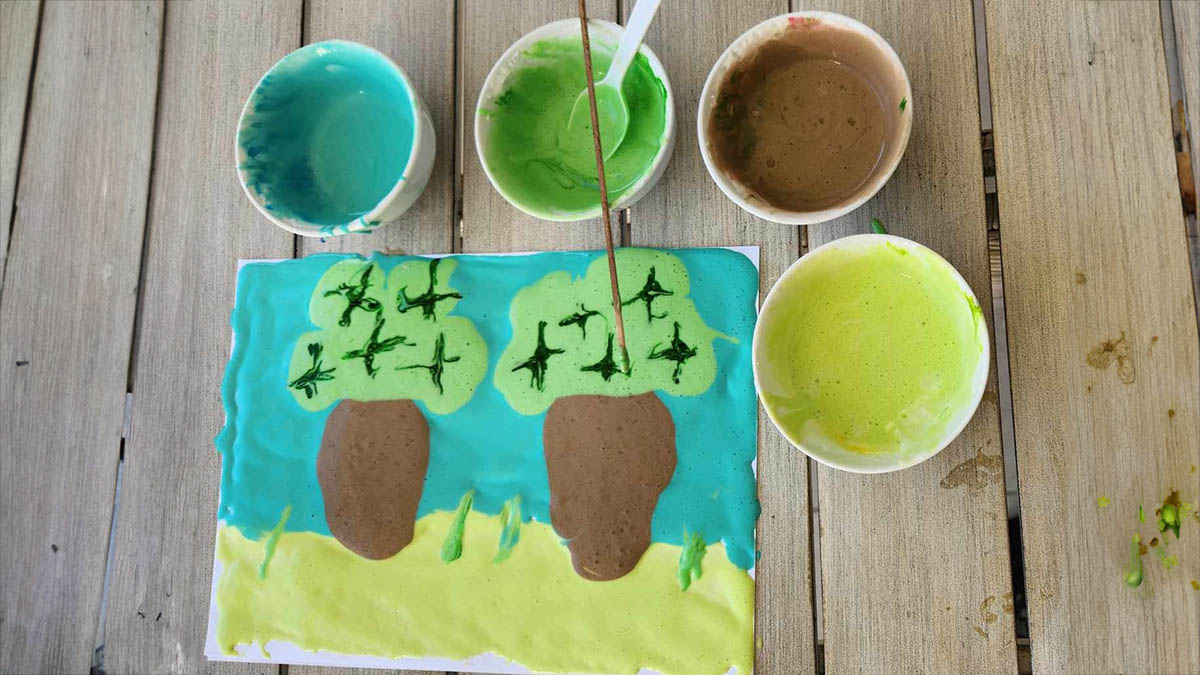Puffy paint, also known as dimensional paint or 3D paint, is a super fun (and only a tiny bit messy) way of creating unique art pieces.
Unlike traditional flat paints, puffy paint keeps its “puff” as it dries, resulting in a textured, raised surface that adds depth and interest to artworks. It’s incredibly easy to make and use, captivating the imaginations of artists and crafters around the world. Its interesting texture and “puffiness” also make it a favourite for kids’ crafts.
What is puffy paint made of?
The easiest and least expensive way to make puffy paint is with a combination of these three household ingredients:
- shaving cream
- school glue
- food colouring
We’ll show you how to make your own below.
Art with puffy paint
One of the great appeals of puffy paint is its versatility. It can be used on a variety of surfaces, including paper, fabric, wood and glass.
Kids love puffy paint for its vibrant colours and tactile nature. It’s an excellent tool for making greeting cards, posters and school projects. As it’s easy to handle, puffy paint is perfect for young artists to explore their creativity without needing a lot of materials.
Puffy paint can be used to add decorative elements to items such as picture frames or wall art. If your child is a budding artist looking for a little touch of noticeable difference to their artwork, puffy paint can add a fun texture and dimension to their paintings and create engaging pieces.
With the ingredients, school glue does wash out, so be sure not to use puffy paint on things that will get wet. Also, food colouring is perfect to create simple artwork pieces. However, if you want more durable colours, you may need to add richer paints such as acrylic paint.
Tips for using puffy paint
To get the most out of puffy paint, consider the following tips:
- Surface preparation: Ensure the surface is clean and dry before applying.
- Application: Use a paintbrush, spoon or other fine-tipped applicators to get the look you want.
- Drying time: Allow ample time for the paint to dry. Depending on the thickness of the application, drying can take anywhere from a few hours to overnight.
Homemade puffy paint recipe

This DIY puffy paint recipe only takes around five minutes to make and gives the kids hours of fun.
Materials:
- ¼ cup shaving cream for each colour
- ¼ cup Elmer’s school glue for each colour
- Food colouring
- Paint brushes in various sizes
- Small bowl or bowls (for the different colour options), or paper plates or plastic cups
Method:
- Mix shaving cream and glue together. (If you want to make 4 different colours, have 4 small bowls with equal amounts of shaving cream and glue in each.)
- Add food colouring choices into each bowl until you get your desired colour.
- The fun begins. Start painting!
Notes:
- As puffy paint is a different medium to most paints, you may need to experiment with the applicators you use for your artwork. You may like to use a toothpick for finer details or a straw to blow the paint. If your paint has air bubbles, you can either work them out of the shaving cream or leave them in for a unique look.
- It’s a fun activity for parents too, so join in on the creativity!
- The puffy texture will eventually dry, but it may take up to 10 hours depending on the thickness. You can keep any leftover glue in ziplock bags.
- If your child is very interested in painting fabrics, you can buy pre-made dimensional fabric paint.
Benefits of puffy paint activities

Puffy paint can also be used for many sensory activities with lots of learning opportunities.
1. Tactile exploration
The unique texture encourages tactile exploration. Children and individuals with sensory processing disorders often seek out tactile experiences to help regulate their sensory systems. The soft, puffy texture provides a soothing and engaging touch experience, promoting sensory integration.
2. Fine motor skills development
Using this unique paint requires precision and control, which can help develop fine motor skills. Squeezing the bottle, guiding the paint onto the surface, and manipulating the paint to create specific designs all require coordination and dexterity. These activities can strengthen the small muscles in the hands and fingers, which are crucial for writing and other fine motor tasks.
3. Hand-eye coordination
Creating artwork with this special paint involves coordinating hand movements with visual input. This practice enhances hand-eye coordination, an essential skill for many daily activities. By following patterns or drawing shapes, individuals can improve their ability to synchronise their visual perception with their motor actions.
4. Creative expression and emotional regulation
Engaging in artistic activities can be a powerful form of creative expression and emotional release. For children and individuals with sensory needs, expressing emotions through art can be therapeutic and calming. The act of painting can help manage anxiety, improve focus and provide a sense of accomplishment.
Sensory activities using puffy paint
Need some help coming up with projects? Here are some you could try.
1. Sensory bags
Create sensory bags filled with puffy paint for a mess-free tactile experience. Simply fill a resealable plastic bag with puffy paint and seal it tightly. Children can squish and manipulate the paint inside the bag, enjoying the texture without getting their hands dirty. This activity is great for toddlers and young children.
2. Textured art projects
Encourage children to create textured art by applying puffy paint to various surfaces like cardboard, canvas or even rocks. They can use their fingers, brushes or tools to spread and manipulate the paint, exploring different textures and patterns. This activity can be adapted for different age groups and skill levels.
3. Sensory play mats
Make sensory play mats using puffy paint to create raised designs on large sheets of paper or fabric. These mats can feature letters, numbers, shapes or simple pictures. Children can trace the designs with their fingers, enhancing their tactile and visual sensory experiences while also learning new concepts.
4. Stamps
Create puffy paint stamps by applying the paint to everyday objects like sponges, leaves or cookie cutters. Press these objects onto paper to create textured prints. This activity combines tactile exploration with creative expression, allowing children to experiment with different textures and patterns.
Paint as simple as that
Who would have thought that a bit of white glue and shaving cream could make puffy paint? And by mixing in a little food colour, you’ve got your very own homemade paint. Kids get inspired by using simple ingredients, so you don’t always need an entire room full of art supplies to make a fun art project. It could be as simple as three ingredients.
Read next
- 13 craft ideas for kids, made from everyday materials
- 3 easy science experiments for kids
- Oobleck recipe: The Dr Seuss science experiment
How helpful was this article?
Click on a star to rate it!
0 / 5. 0
Be the first to rate this post!
Adriana Wales
Related posts
Subscribe
Receive personalised articles from experts and wellness inspiration weekly!

